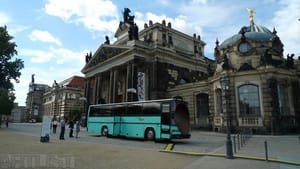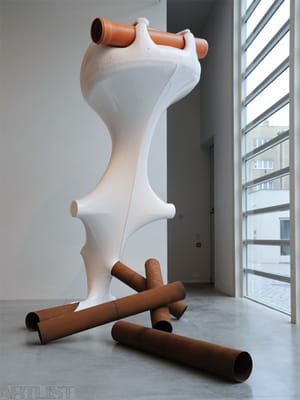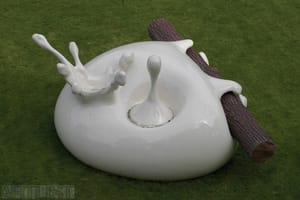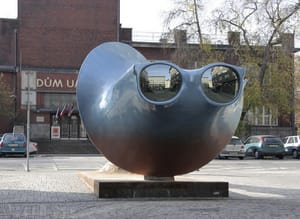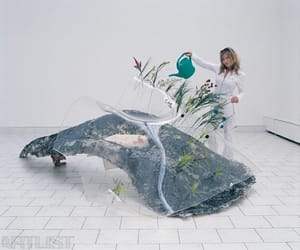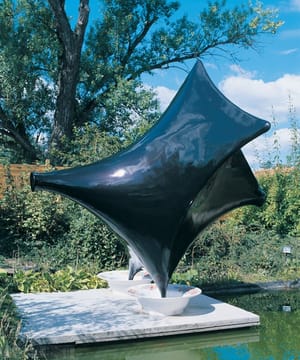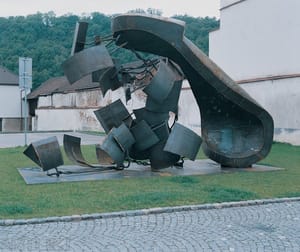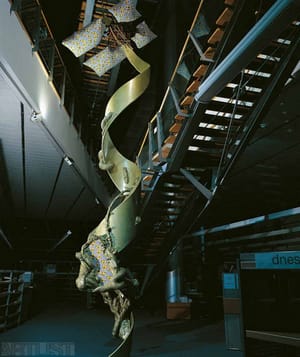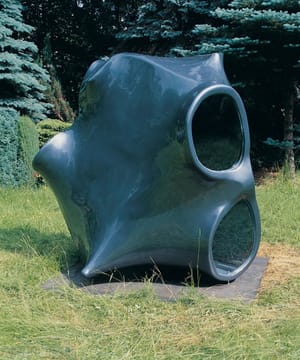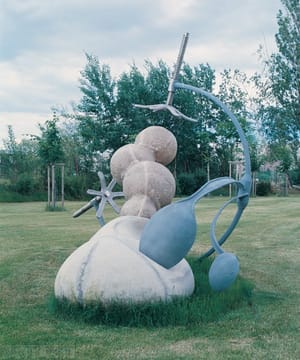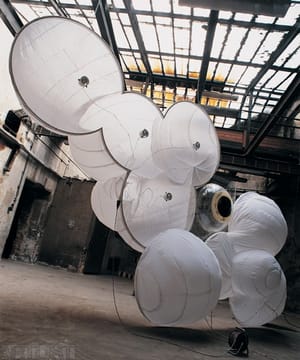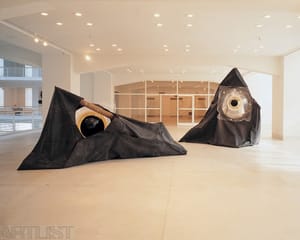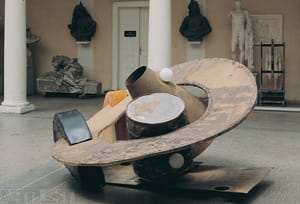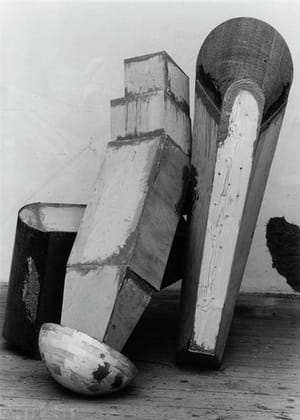- First Name
- Lukáš
- Surname
- Rittstein
- Born
- 1973
- Birth place
- Prague
- Place of work
- Prague
- Website
- www.lukasrittstein.com
- i-datum
- ↳ Find in the VVP AVU database
- Keywords
- CSU Library
- ↳ Find in the catalogue
About artist
Lukáš Rittstein graduated from the Academy of Fine Arts in 1997. While still a student, he showed that he was a sculptor of unmistakable qualities. Typical for his work is the use of a wide range of objects of everyday life or industrial materials that he sometimes combines with his own forms made from fibreglass.
He has created several dozens of sculptors over his short career. Each of them is connected with an aptly deep story related to the artist's life, recollections and his rich imagination. Last but not least an interest in environmental and globally valid questions on the fate of our planet has contributed to his work. This is nourished above all by his interest in the fourth world, living in areas still uncontaminated by our civilisation. Of fundamental importance have been the trips he made with his girlfriend Barbora Šlapetová to Papua New Guinea where he met with the life of its inhabitants, still unchanged by the outside world.
The first series of Rittstein's sculptures, some of which were created while he was still a student in 1994-1998, is entitled From Kitchen to Saturn. As the artist himself says, the internal and external universes are compared in this cycle. From Kitchen is a sculpture composed of several objects connected to the artist’s grandmother’s life. The sink, in which she scraped potatoes, the small tub that he bathed in when he was small and other objects are a reminder of moments of the artist’s childhood: “I symbolically experienced the internal universe and reconstructed the remembering of the remembrance of my grandmother’s things," he said. The Saturn sculpture, made from industrial materials, is for the artist a symbol "of the merging of silhouettes of an industrial landscape with lights of the celestial bodies over it.” The rawness of the used materials uniquely resonate with the fragile feeling of the universe’s infinity.
This is followed by the Snapshots cycle from around and shortly after 2000. The artist speaks of these sculptures as of a landscape of volatile feelings. Transience, temporality, impermanence, elusiveness – such is the everyday situation; such is the existence of man. Some of the sculptures bear characteristic titles such as Elusive, in which Rittstein captured in an almost Baroque-allegorical way a feeling of an ever fleeting world, despite our attempt to hold or anchor the thing: “From one side the form flows away, from the other side it evaporates and the attempt to capture it is useless - a construction of clamps and spoons attempts to grasp it to no avail," said the artist in describing this sculpture.
For the Dirty Sky series (made ca. 2000-2003) the common denominator for the sculptures is a laminated amorphous form that the artist casts from holes dug in the earth. This is combined with other objects of daily reality – such as dustbins and curtains, such as in the sculpture Dreaming One. Two beams of light stream from a Baroque-like floating cloud, protruding from dustbin tops: “It’s a cloud with Baroque-like light beams, but it’s also a dreaming face over a landscape or toxic smoke coming from dustbins," said Rittstein. At the same time he started to create the Clean Sky series. A shared trait of these sculptures is the material used, also used to make the bodies of cars. It’s a kind of metallic skin stretched and polished to a perfect surface and painted celestial colours - colours of red twilight, azure or of the night sky. Thematically, this usually concerns the communication and relationship of two people. In the sculpture Together, Rittstein enlarged his grandmother's and grandfather's eye-glasses and forged them into a form that conceives them in a single space: “It’s the symbiosis of man and woman - a merging of “the thoroughly viewed” under a single skin. These two people will be in an eternal embrace. The sculpture is about their feelings and about what they saw, what is written in the stars," said Rittstein.
The latest cycle is a series of sculptures called Forest. The work is inspired by the artist's many years in the jungle in Papua New Guinea where he was intensely aware of the disappearance of the wilderness. These sculptures are loosely inspired by globalisation, environmental questions and civilisation problems. They are always made of a round, soft-like form that holds horizontal artificial timber as if the soul is attached to the axis of its existence” (Rittstein). Each of the sculptures has its own, specific story, whose meaning is, however, generally symbolic: It’s a search for a deeper anchoring of man in contemporary society. This experience formed with Rittstein when he lived among the indigenous tribes where he intensely experienced the staggering disappearance of man's original connection with the world of nature. Rittstein’s work is voluminous and multivalent. The artist’s vast imagination and intensive experience of civilisation aspects of human existence in a universal context is omnipresent. All of Rittstein's work is thus characterised by a confrontation of the internal and external universe.
- Author of the annotation
- Ivona Raimanová
CV
Studies:
1997-1999 PhD studies at the Academy of Applied Arts, Architecture and Design, Prague, glass in architecture, Marian Karel
1987-1991 Secondary school of Vaclav Hollar, Prague
1991-1997 Academy of Fine Arts, Prague
studio of sculpture (Hugo Demartini),
studio of concept art (Aleš Veselý)
Expeditions in 1997, 1998, 1999, 2001, 2002, 2006, 2008 Papua New Guinea,
Western Papua, Salomon Islands
Awards:
2005 Cena Magnesia Litera v kategorii Objev roku za knihu Proč je noc černá, s Barborou Šlapetovou (vydal Kant 2004)
1999 Cena Jindřicha Chalupeckého
1997 Cena Václava Chada z 1. Zlínského salonu mladých
Scholarships:
2000 Stipendijní pobyt v Centru pro umění Headlands v Sausalitu ( Kalifornie, USA)
Exhibitions
- Solo exhibitions
-
2011
Tour. Staatliche kunstsammlungen Dresden, Bruhlsche Terrase Albertinum
2010
Klíčovou dírkou a naopak. S Barborou Šlapetovou a s Michaelem Rittsteinem,
Galerie města Plzně
Přemístění. S Barborou Šlapetovou, Galerie Dole, Ostrava
2009
Manop - poslední první. S Barborou Šlapetovou. DOX - Centrum současného umění, Praha
Přemístění. S Barborou Šlapetovou. Galerie moderního umění v Roudnici nad Labem
Nepřistupuj blíž. S Barborou Šlapetovou. Galerie města Blanska
2008
Virtuální bolest. Moravská galerie – prostor pro jedno dílo, Brno
2007
Proč je noc černá. S Barborou Šlapetovou. České centrum, Mnichov
Šílené holky v lese. S Martou Morice. Galerie Ars, Brno
2006
Les. Galerie Klatovy/ Klenová
Mléko a hlína. S Barborou Šlapetovou. Slovácké Muzeum, Uherské Hradiště
2003
Vaříme na Marsu dobrotu pro dva. S Michaelem Rittsteinem. Gallery No. 4, Cheb - kostel Sv. Bartoloměje
Den co den. České centrum, New York
2002
Sochy a fotografie. S Barborou Šlapetovou. Muzeum v Bruntále – zámek
Lukáš Rittstein. Výstavní síň Sokolská 26, Ostrava
Bytosti. Galerie Astra, Kuřim – zámek
2001
Momentky. Výstavní síň Mánes, Praha
2000
Modrý prosinec. S Barborou Šlapetovou. Galerie Václava Špály, Praha
1999
Od kuchyně k Saturnu. Státní galerie ve Zlíně
Od kuchyně k Saturnu. Sbírka moderního a současného umění Národní galerie v Praze – Veletržní palác
Od kuchyně k Saturnu. Dům umění v Českých Budějovicích
1998
Krabice, police, ale i rám. Galerie Pecka, Praha
- Group exhibitions not included in ARTLIST.
-
2011
Sochařské studio Bubec 2000-2011 / The Bubec scupture Studio 2000-2001, Staroměstská radnice, sklepení, Praha
2010
3x1. Galerie Mona Lisa, Olomouc
Expo Shanghai
Cena Jindřicha Chalupeckého - Laureáti dvacet let. DOX, Praha
2009
Re-reading the Future. National Museum of Bulgarian Art, Sofie (Bulharsko)
2008
Mezinárodní trienále současného umění – Re-reading the Future. Národní galerie v Praze – Veletržní palác
Re-reading the Future. Kuva – Art Academy Helsinki (Finsko)
Re-reading the Future. Perve Galeria, Lisabon (Portugalsko)
Zrozeno do prostoru. Umělecká beseda. Hrad Sovinec
Sochy v ulicích. Brno
Ultra. Galerie Zdeněk Sklenář, Praha
Dialogy. Kalendáře pro Jindru Štreita. Galerie Smečky, Praha
Art Beijing 2008. (s Galerií Zdeněk Sklenář) Peking (Čína)
Aeronale. Letiště Praha
2007
Ohňostroj krásy. Galerie Zdeněk Sklenář, Litomyšl
Forma následuje… risk. Karlín Studios, Galerie Futura, Praha
Forma následuje… risk. Slovenská Národná galéria v Bratislavě (Slovensko)
2006
Od země přes kopec do nebe. Galerie Klatovy / Klenová
Les. Galerie města Plzně
Hotel Chalupecký. Motorenhalle, Centrum pro současné umění, Drážďany (Německo)
Kvalitní řešení. Galerie moderního umění v Hradci Králové
Otcové a synové. Galerie Konzum, Brandýs nad Orlicí
Proces. Holešovická tržnice, Praha
2005
V mezičase. NCCA - Národní centrum pro současné umění, Moskva (Rusko)
Imprese. Galerie Rudolfinum, Praha
Sculpture Grande 2005. Praha
Od země přes kopec do nebe. Severočeská galerie výtvarného umění v Litoměřicích
2004
Vision. Galerie Kritiků, Palác Adria, Praha
The Visions, Galerie Toki, Tokyo (Japonsko)
Škola monumentální tvorby prof. A. Veselého. Wortnerův dům AJG v Českých Budějovicích
V mezičase. Galerie Kritiků, Palác Adria, Praha
E.U. Positive. Akademie der Künste, Berlín (Německo)
2003
Zahrada. Michal Gabriel a hosté. Barbora Šlapetová a Lukáš Rittstein. Galerie Tvrdohlaví, Praha
Golem. Museo Nacional de bellas Artes, Buenos Aires (Argentina)
5º pod rovníkem. Galerie Kritiků, Palác Adria, Praha
Svět jako struktura, struktura jako obraz. Galerie Klatovy/ Klenová
III. Zlínský salon mladých. Státní galerie ve Zlíně
Labyrint světa a ráj srdce. Galerie Konzum, Brandýs nad Orlicí
O technice. České muzeum výtvarných umění v Praze
2002
Divočina – příroda, duše, jazyk. Galerie Klatovy / Klenová
2001
The New Connection (Nové spojení). Světové finanční centrum, New York (USA)
Nové spojení. Galéria města Bratislavy (Slovensko)
Melancholie. Moravská galerie v Brně
2000
II. Zlínský salon mladých. Státní galerie ve Zlíně
L´Art dans le monde 2000 (Světové umění 2000). Cullée du Pont Alexandre III, Paříž (Francie)
Klasika 2000. Muzeum umění Olomouc
Stories from the Mid-Land (Příběhy ze Středo-Zemí). Galerie Kulturhuset USF, Bergen (Norsko)
1999
O přírodě. Badisher Kunstverein, Karlsruhe (Německo)
O přírodě. Le Centre d´Art Contemporain de Rethynmnon (Řecko)
Umělecká beseda. Výstavní síň Mánes, Praha
České současné umění. Česká a Slovenská ambasáda, Londýn (Velká Británie)
Finále. Cena Jindřicha Chalupeckého 99. Národní galerie v Praze - Veletržní palác
Neplánované spojení. Výstavní síň Mánes, Praha
1998
Sklizeň II. Výstavní síň Mánes, Praha
O přírodě. České muzeum výtvarných umění, Praha
Dary a nákupy. Sbírka moderního a současného umění Národní galerie v Praze
Tschechische Kunst (České umění). České kulturní centrum, Bonn (Německo)
La nature en dix chapitres – Artistes contemporains tchéques (Příroda v deseti kapitolách – současní čeští umělci). Centre Rhenan d´Art contemporain Alsace, Altkirche (Francie)
1997
1. Zlínský salon mladých. Státní galerie ve Zlíně
Bienále mladých Zvon. Poprad (Slovensko)
Fruchte aus Prag (Ovoce z Prahy). České centrum, Berlín (Německo)
International 97. Socrates Sculpture Park, New York (USA)
Snížený rozpočet. Výstavní síň Mánes, Praha
1996
Konfrontace. Svárov
1995
Zkušební provoz. Výstavní síň Mánes, Praha
Bienále malé plastiky. Murska Sobota (Slovinsko)
1993
Demartini – sochařská škola II. Galéria Medium, Bratislava (Slovensko)
Realizations in Architecture and Public Space:
2010 Silná barva. Kampus Masarykovy Univerzity v Brně
2007 Věčná něha. Tramvajová zastávka v Liberci
2005 Úsvit. Umělecká ulice v Ostravě
2002-2004 Sochařská část interiéru Pavilonu indonéské džungle v Pražské ZOO, spolu s Barborou Šlapetovou a Michalem Gabrielem
2003 Žíla. Krajská vědecká knihovna v Liberci
2003 Den co den. Náměstí v Brandýse nad Orlicí
2000 Vlny. Lékařská fakulta Masarykovy Univerzity v Brně
2000 Nepolapitelná. Archiv hlavního města Prahy, Jižní Město
- Collections
-
Sbírka moderního a současného umění Národní galerie v Praze
Státní galerie ve Zlíně
Galerie Klatovy / Klenová
Albertinum Dresden
Soukromé sbírky
- Other realisations
2005
Daybreak – Ostrava, Umělecká street
2002-2004
Sochy a umělá džungle v pavilonu indonézské džungle v pražské zoo s Barborou Šlapetovou a Michalem Gabrielem
2003
Vine – Library in Liberec
Day by day – Brandýs nad Orlicí
2001
Illusive One – State Archive in Prague
2000
Wawes – Medical Faculty
Monography
- Monography
Nepřistupuj blíž. Kniha rozhovorů s přírodními lidmi Nové Guineje - rozsáhlejší vydání. S Barborou Šlapetovou. Nakladatelství Euromedia a Galerie Zdeněk Sklenář, Praha (2009)
Vědomí věčně něžných já. Monografie. Galerie Zdeněk Sklenář a Galerie Klatovy/Klenová, Praha (2009)
Mléko a hlína. Katalog k výstavě v Slováckém muzeu v Uherském Hradišti. S Barborou Šlapetovou. Uherské Hradiště (2006).
Proč je noc černá. Kniha rozhovorů s přírodními lidmi Nové Guineje. S Barborou Šlapetovou. Nakladatelství Kant, Praha (2004).
Momentky. Katalog k výstavě ve výstavní síňi Mánes. Praha (2001).
Modrý prosinec. Katalog k výstavě v Galerii Václava Špály. S Barborou Šlapetovou. Praha (2000).
Od kuchyně k Saturnu. Katalog k výstavě v Národní galerii v Praze, ve Státní galerii ve Zlíně a v Domě umění v Českých Budějovicích. Praha (1999).
- Articles
Robert Janás. Socha nebo objekt. Art and Antiques (léto 2008): s. 36–42.
Petr Volf. To umí jen nebe (rozhovor). Reflex, č. 2 (11. 1. 2007): s. 42–44.
Karolína Jirkalová. Lukáš Rittstein. Art & Antiques (únor 2007): s. 32, 33.
Ivona Raimanová. Socha jako lavička. Ateliér, č. 20 (2007): s. 12.
Martin Mašek. Vorvaň je připraven. Euro, č. 27 (2. 7. 2007)
Kateřina Pažoutová. Rozmazané modelky a laminátové duše. Ateliér, č. 24
(6. 12. 2007): s. 4.
. Jiří Zemánek. Ukázka díla. Ejhle světlo (publikace vydaná u příležitosti stejnojmenné výstavy v Moravské Galerii, Brno a v Jízdárně Pražského hradu, Praha). Vydaly: nakladatelství Kant a Moravská galerie v Brně (2003): s. 106.
Jiří Machalický. Hravé Imprese v Rudolfinu. Lidové noviny (25. 10. 2005)
Jiří Zemánek. Od země přes kopec do nebe… (publikace ke stejnojmenné výstavě). Vydaly: Arbor vitae, Severočeská galerie výtvarného umění v Litoměřicích a Galerie Klatovy/ Klenová (2005): s. 166.
Tomáš Pospiszyl. Žíla pro Mejlu. Týden, č. 34 (18. 8. 2003): s. 76.
Jiří Zemánek. Divočina – příroda, duše, jazyk (publikace ke konferenci Divočina jako fenomén integrální kultury). Vydavatel Kant (2003): s. 18, 152.
Petr Volf. Lukáš Rittstein: Plastika Den co den (Brandýs nad Orlicí). Reflex, č. 40
(2. 10. 2003): s. 52.
Ivona Raimanová. Lukáš Rittstein: Memory and Extinction (Lukáš Rittstein: Paměť a vyhynutí). Sculpture (květen 2002): s. 20–21
Richard Guryča. Rittstein: Umění má být divné. MF Dnes (7. 7. 2001): s. C/3.
Jiří Machalický. Sochař Lukáš Rittstein ovládl Mánes. Lidové noviny (14. 7. 2001)
Jan H. Vitvar. Vysochaná intimní zpověď. MF Dnes (13. 7. 2001)
Sylvia Petráková. Momentky Lukáše Rittsteina jsou o stavu duše. Právo (16. 7. 2001)
Magdalena Juříková. Momentky všemi smysly. Ateliér, č. 16–17 (30. 8. 2001): s. 4.
Blanka Jiráčková, Olga Malá. Vratkost našeho bytí. Ateliér, č. 16–17 (31. 8. 2000): s. 1–2.
Věra Jirousová. Finále Ceny Jindřicha Chalupeckého 1999. Ateliér, č. 1 (13. 1. 2000): s. 16.
Jiří Hůla. Pohyb v moderním umění se podobá cestě divočinou. Lidové noviny
(23. 6. 2000): s. 21.
Monika Čermáková. Lukáš Rittstein popisuje zvyky zanikající civilizace.
MF Dnes (8. 6. 2000): s. 3.
Jiří Hůla. Soustředíte se na nosnou podstatu (rozhovor s Lukášem Rittsteinem a Barborou Šlapetovou). Ateliér, č. 14–15 (13. 7. 2000): s. 6.
Jiří Zemánek. Nostalgie mizející divočiny. Modrý prosinec (kat. výst. Galerie Václava Špály, Praha, 31. 5.–25. 6. 2000). Praha (2000): s. 103–105.
Jiří Zemánek. My všichni jsme ohrožení křupani. Ateliér, č. 14–15 (13. 7. 2000): s. 16.
Jiří Zemánek. O celostní vizi reality a dialogickém způsobu poznávání světa. Proměny řádu – chaos a řád (sborník konference, Národní galerie v Praze, 19.–20. 10. 2000); vydala ČVUT v Praze (2000): s. 18–24.
Jiří Zemánek. Sochařské příběhy a hry Lukáše Rittsteina. Lukáš Rittstein: Od kuchyně k Saturnu (kat. výst. Národní galerie v Praze, 6. 5.–29. 8. 1999). Praha (1999): s. 3–48.
Jiří Valoch. Důsledné rozšiřování sféry sochařství. Ateliér, č. 14–15 (8. 7. 1999): s. 16.
Petr Volf. Od kuchyně k Saturnu. Reflex, č. 28 (15.7.1999): s. 54.
Lenka Lindaurová. Lukáši Rittsteinovi se daří jít za svými vizemi. MF Dnes (26. 11. 1999)
Jiří Hůla. Rittsteina inspirují nečekaná setkání s obyčejnými věcmi. Lidové noviny
(9. 6. 1999)
Jeff Crane. Lukáš Rittstein. Artforum (říjen 1999): s. 155.
Jiří Ptáček. Rittstein míří od Saturnu ke hvězdám. MF Dnes (9.12.1999)
Eva Zajíčková. Nová Guinea splnila Lukáši Rittsteinovi sen o dobrodružství (rozhovor).
MF Dnes (27. 11. 1999): s. 3.
Ivona Raimanová. Rozhovor s Lukášem Rittsteinem o jeho cestě na Novou Guineu. Lukáš Rittstein: Od kuchyně k Saturnu (kat. výst. Národní galerie v Praze, 6. 5. – 29. 8. 1999)
Věra Jirousová. Sochaři z Čech vystavují na Manhattanu. Lidové noviny (2. 1. 1998): s. 11.
Monika Čermáková. Prostě si urovnávám hlavu, říká sochař Lukáš Rittstein (rozhovor).
MF Dnes (4. 8. 1998): s. 9.
Martina Pachmanová. Živel současného českého umění. Ateliér, č. 8 (16. 4. 1998): s. 9.
Radek Wohlmuth. Lukáš Rittstein: Krabice, police, ale i rám. Ateliér, č. 8
(16. 4. 1998): s. 5.
Vít Havránek. Lukáš Rittstein: Práce z posledních čtrnácti let. Detail, č. 1, roč. III, (1998): s. 14.
Pavla Pečinková. Art contemporain tcheque (Současné české umění). Beaux Arts, č. 168 (květen 1998): s. 30–31.
Jiří Zemánek, Lukáš Rittstein. I. Zlínský salón mladých (kat. výst. Státní galerie ve Zlíně, 20. 5.–17. 8. 1997): s. 64.
Karolína Fabelová. Socha jako dobrodružství (rozhovor). Umění a řemesla, roč. 39, č. 4. (1997): s. 34–35.
Martin Reissner. I. Zlínský salon mladých. Svobodné slovo (3. 6.1997)
Kateřina Pažoutová. I. Zlínský salon mladých. Ateliér, č. 17–18 (28. 8. 1997): s. 4.
Charlotta Kotík. Pohled z Manhattanu. Ateliér, č. 4 (19. 2. 1996): s. 1.
Ivona Raimanová. Sculpture in the New Central Europe – Czech Republic (Sochařství v nové Střední Evropě – Česká republika). Sculpture (prosinec 1996): s. 36–38
- Personal texts not included in database
2004
“Why Is The Night Black” s Barborou Šlapetovou, obrazová cestopisná publikace z oblasti Papui Nové Quinee
